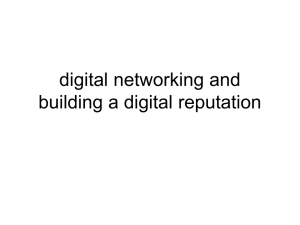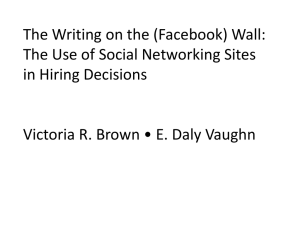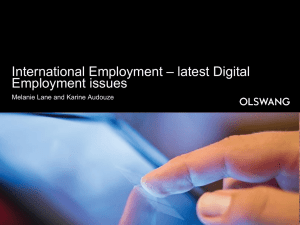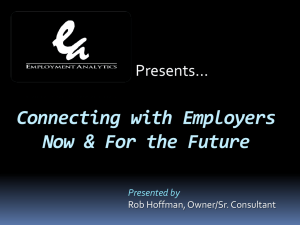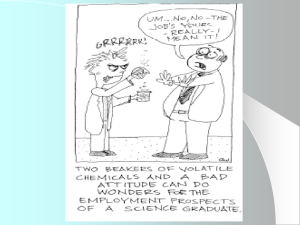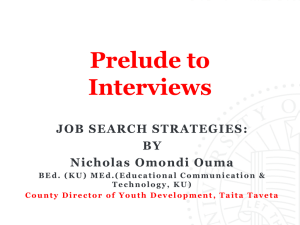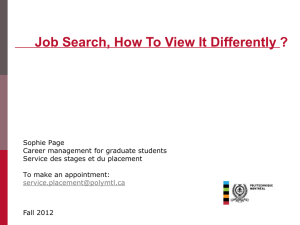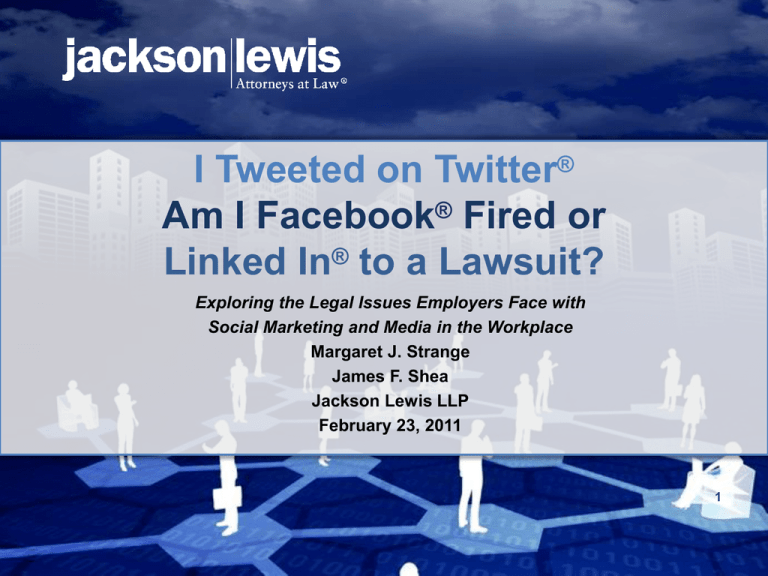
I Tweeted on Twitter®
Am I Facebook® Fired or
Linked In® to a Lawsuit?
Exploring the Legal Issues Employers Face with
Social Marketing and Media in the Workplace
Margaret J. Strange
James F. Shea
Jackson Lewis LLP
February 23, 2011
1
What We Will Discuss
• Social media and the basics of popular
social networking/media sites.
• How to use social networking information
for hiring and other employment actions.
•Potential employer liability from social
networking including harassment and
privacy issues.
• How employers can manage employees’
use of social and electronic media during
and after work.
2
What are “Social Media”
• Social Media Sites
– MySpace ®
– FaceBook ®
– LinkedIn ®
• On-Line Media
– Hulu ®
– YouTube ®
• Texting
• Email
• Instant
Messaging
• Blogs
– Twitter ®
3
4
Facebook
5
Linked in
6
Sample MySpace® Page
7
Sample MySpace® Profile
8
Social Networking Sites:
All the Rage
9
Social Networking Sites:
All the Rage
• Two-thirds of the world’s internet
population visits social networking sites
• Facebook has more than 400 million
users
– On average, each user spends
minutes per day on Facebook
55
(Source: Facebook Press Room, http://www.facebook.com/press/info.php?statistics (last visited Mar. 3, 2010))
10
Social Networking Sites:
All the Rage
• Use of Twitter – the latest digital
sensation – has soared more than 1,200
percent
• As Twitter has expanded, its largest user
group is 25-54 year olds
11
Social Networking Sites:
All the Rage
• In February 2009, time spent on social networks sites (sns)
surpassed email for the first time
(Source: Teddy Wayne, “Social Networks Eclipse E-Mail,” The New York Times, May 18, 2009)
•
•
•
•
•
22% of employees visit sns 5 or more times per week; 23% visit 1-4
times per week
52% of employees choose not to use sns during work hours
10% of employees visit for both business & personal reasons; 6% say
they visit for business only
74% of employees say it’s easy to damage a company’s reputation on
social media and 15% say if they disagreed with an employer’s
actions they would comment online
53% of employees say their social networking pages are none of their
employer’s business, but 40% of business executives disagree
with 30% admitting to informally monitoring
12
(Source: 2009 Deloitte Ethics Workplace Survey)
Hiring Using
Social Networking Sites
13
Using Social Media for
Recruitment
• Attract Employees – through FaceBook® presence or
advertising, LinkedIn® discussion board or YouTube®
• Source of Candidates – Twitter®, LinkedIn®
• Engage Candidates – gather information from target
employees for profiles
• Screen Applicants – look at profiles
• Close the deal – welcome through conversations on
social network
14
Hiring & Social Networking
• In one survey by CareerBuilder.com,
45% of participating employers said
they use social networking sites to
research job candidates
• Of this group, 35% rejected potential
job candidates because of content they
found on their SNS
Source: CareerBuilder Survey dated August 19, 2009
15
What are You Likely to Find on a
Social Networking Site?
• Education History
• Vacation Photos
• Work History
• Party Photos
• Career Interests
• Family
Information
• Hobbies
• Memberships
• Favorite Movies
• Drug Use
• Poor Judgment
• Links to Profiles
of Friends
• Links to Blogs
• Political Views
16
Would You Hire Him as an
Employee?
17
Do you have the same response
now?
18
Hiring & Social Networking
– According to some reports, as many as 50% of
employers and 77% of job recruiters check out
potential employees on the Web.
• Using search engines such as Google or Yahoo and internet
sites such as PeopleFinders.com, Local.Live.com or
Zillow.com, Facebook, MySpace and other networking sites.
Source: MySpace Is Public Space When It Comes to Job Search, CollegeGrad.com
19
Hiring & Social Networking
• There is no law that directly prohibits the use
of SNS in the hiring process.
• There has been no reported increase in
failure-to-hire cases based on information
obtained from SNS.
• There is no law which requires the use of
SNS in the hiring process.
• But there are RISKS to accessing and using
such information.
20
Risks for Employers
• Hiring Issues Associated with Using the Web
–
–
–
–
–
Lawful background checks? FCRA?
Discrimination concerns?
Lawful-off duty conduct?
First Amendment protections under Connecticut law?
Reliability? Even if not unlawful, employer may make
employment decisions based on inaccurate
information.
21
Risks for Employers
• Discrimination Concerns
– Viewing applicant’s personal information on social
networking sites may trigger anti-discrimination laws.
– Access to information regarding protected status?
• Age, disability/medical information, race, sex, religious beliefs,
pregnancy, sexual orientation, military status, marital status or other
protected characteristic
–
–
–
–
Learn about applicant’s workers’ compensation claim
Learn about criminal or arrest histories
Invasion of privacy / Intrusion upon seclusion
Pretexting and fraud concerns
22
Risks During Hiring
• Once accessed, difficult to prove the
employer did not rely on protected
personal information.
• Information obtained can be used
against employer if applicant not hired or
if hired and an employment dispute later
arises.
23
Risks During Hiring
• Legal off-duty conduct
– Some states have laws that prohibit employers from
considering legal off-duty conduct when making adverse
employment decisions:
– About 9 states, including California, New York, Colorado,
and North Dakota, have statutes known as “lifestyle
discrimination” laws, which ban discrimination based on
legal, off-duty recreational behavior.
– An employer could violate these laws by refusing to hire an
employee after discovering from a SNS that, for example,
the employee was drinking at a party, smoking or engaging
in political activity.
– Connecticut law protects exercise of rights under the
1st Amendment.
24
Risks During Hiring
• Reliability
– Employers may mistakenly gather information about or access
the account of a person other than the applicant.
– Facebook page or website seemingly run by applicant may not
be created or even known by the applicant.
– False information may be posted on blogs or social networking
sites.
– Case of mistaken identity.
– Keep in mind that reputable news sources are continually
coming under fire for relying on unsubstantiated, internet-based
information.
25
Lessons Learned—Hiring
• If you are going to use SNS for hiring
decisions:
– Develop policy on whether employer will search internet or
access social networking sites for job applicants.
– Do so consistently and in a uniform manner.
– Make sure candidates are notified, in writing, about the
company’s use of SNS to gather information.
– Consider searching social networks only after the initial inperson interview with the applicant.
– Ensure appropriate employment decisions are made based on
lawful, verified information.
26
Lessons Learned—Hiring
– Designate non-decision maker to conduct search.
The
individual should be properly trained to avoid improper access
and to screen out information that can not be lawfully
considered in the decision-making process.
– The non-decision maker can then provide “scrubbed”
information to the decision maker for consideration.
– Rely on job-related criteria (preferably from a job description).
– Be aware of relying on legal, off-duty conduct.
– Follow best practices: identify a legitimate, non-discriminatory
reason for the hiring decision with documentation supporting the
decision.
27
Firing & Social Networking
28
Examples of Employer Use of Electronic
Information/Communication to Fire
29
Employees Use SNS to…
• An airline attendant posted provocative pictures of
herself on her personal blog while wearing her uniform
on a company plane
• An employee of a computer company posted a picture
on his personal blog that included competitor’s
computers the company had purchased
• A sports writer posted inflammatory comments on his
blog about the ethnic heritage of producers of certain
movies
• A former software company employee sent 200,000 emails to 35,000 employees complaining about his
30
treatment by the company
And . . .
• Cohasset school administrator posted Facebook
comments disparaging residents of town as “snobby
and arrogant.”
• Windsor Locks superintendent resigned after he
posted on his Facebook page that he had counseled
an administrator to retire or face termination. He
followed his comment with a smiley face.
• Man employed by a professional football team was
terminated after he criticized a recent personnel
decision by the team on his Facebook page.
31
And . . .
• A TX disc jockey was fired for blogging about his
homosexual dating habits on the company MySpace
page
• A FL sheriff’s deputy was fired after he posted
comments about swimming nude, drinking heavily,
female breasts and other topics on MySpace
• A CA automobile club fired 27 employees who made
objectionable comments on MySpace, including
remarks about a co-worker’s weight and sexual
orientation
32
Example of Employee Misuse of
Electronic Information/Communication
33
Firing & Social Networking
• Can Employers Base Termination Decisions on
an Employee’s MySpace or Facebook page?
– Yes, if does not violate discrimination or other
employment laws.
No prohibition on using public
information.
– Refrain from accessing restricted information.
– To be safe:
perform such searches consistently,
document them, get information from reputable sources
(accuracy) and be sure the info is truly job-related.
– Follow standard procedure for investigating
34
allegations of misconduct
Dealing with Employees who Misuse
Electronic Communications
• Consider the following when disciplining
employees based on electronic communications:
– Was the communication protected activity under the
National Labor Relations Act?
Is it protected,
concerted activity?
– Could the employee be protected under a
whistleblower statute?
– Is the conduct protected by anti-retaliation provisions
of fair employment statutes?
35
Dealing with Employees who Misuse
Electronic Communications
– Was the communication otherwise protected?
• Legal off-duty conduct?
• Was the communication political conduct?
• Is the conduct protected by 1st Amendment?
– Adhere to normal best practices for
investigations of alleged employee
misconduct: conduct thorough investigation,
document witness interviews, identify policy
violation, interview accused employee and
follow progressive discipline.
36
Potential Liability From Social Media
37
Risks for Employers
• General Areas
– Exhibitionism: lack of filtering when posting information
– Voyeurism: searching for information
• Electronic Footprints
– Shows where you have been and what you have been doing on
line
38
– Can be used for e-discovery
Risks for Employers
•
Harassment or Bullying by Employees
– Textual harassment or sexting
•
Discrimination
– Employer sponsorship of blog
• Ratification of content by inaction
• Obligation to take action to prevent or eliminate inappropriate content
once on notice
– Employer viewing applicant information
• Sites may contain information regarding protected status
• Information can be garnered that cannot be asked in an interview
• May become evidence of what you knew when making employment
decision.
• Difficult for employer to prove it did not view and rely upon
39
the information when making decision
Discrimination, Harassment and
Retaliation
– Electronic communications
provide employees with an
opportunity for misuse and
can be used as evidence to
support a harassment or
discrimination claim
– Knew or should have known
standard applies
– Blakely v. Continental
Airlines, Inc., 164 N.J. 38
(2000)(Company has duty
to take effective measure to
stop harassment via “Crew
Member Forum” once it
knew or should have known
harassment was taking
place)
– What about off-duty
conduct?
40
40
41
Reputational Harm to Employers
•
Blogs and other electronic communications also
may have dramatic negative consequences for
employers:
– Domino’s, Burger King, KFC – Employees posted
video/photographs harming company image
– Former Intel employee sending 200,000 e-mails to 35,000
employees complaining about his treatment by Intel
– California jury awarded employer $775,000 in compensatory
and punitive damages against former employees for
“cybersmearing” of employer. Varian Medical Systems, Inc. v.
Delfino, Santa Clara Super. Ct. No. CV780187
41
(Dec. 18, 2001)
42
Business Proprietary Information
• Intellectual property
infringement
– Microsoft employee
posted software upgrade
• Securities fraud/Unfair Competition
– Whole Foods CEO’s anonymous blogging
criticizing competitors led to unfair
competition lawsuit and FTC/SEC
investigation
42
Risks for Employers
• Negligent Referral
– FaceBook®, LinkedIn®, and Twitter® allow users to
post recommendations from their employers.
• Employee expects detailed favorable
recommendation
• Favorable on-line reference may conflict with
employee performance evaluations
• Negative online recommendation may be the basis
for defamation claim.
43
44
Risks for Employers
• Negligent Supervision/Retention: An employer
may be held liable for an employee’s wrongful acts if the
employer knew or had reason to know of the risk the
employment created
–
Doe v. XYC Corp., 382 N.J. Super. Ct.122 (2005)
(Court found employer held employer had duty to
investigate and respond in case of alleged negligent
supervision of employee who was criminally charged
with child pornography using workplace computer)
44
Risks for Employers
• Violations of Security Laws
– Disclosure of non public material information
• Unfair Competition/False Advertising
– Federal Trade Commission Guides
• Employer may be liable for violation if employee does not
disclose relationship to employer when employee posts
regarding products and services
45
Risks for Employers
• Wrongful Termination
– Potential First Amendment Speech claims by public sector
employees
– Potential Sarbanes Oxley violation where employee reports
unlawful conduct online and is terminated
• Not sure yet whether publication in a blog satisfies reporting
requirement
– Potential NLRA violation where employee complains in blog
about company practices regarding pay, working conditions
– Potential anti-retaliation violation where employee terminated for
complaining in blog that manager treats blacks differently than
whites
46
Developing Case Law - Privacy
• Quon v. Arch Wireless Operating Co. Inc., 554 F.3d
769 (9th Cir. 2008) cert. granted (Dec. 14, 2009)
–Failure to monitor supported employee expectation of privacy
–“Workplace realities” debate
• Brown-Criscuolo v. Wolfe, 601 F. Supp. 2d 441 (D.
Conn. 2009)
– Policy granting employees a “limited expectation of
privacy” in their personal files and failure to regularly
monitor supported claim of violation
Developing Case Law - Privacy
• Stengart v. Loving Care Agency, Inc., 2009 N.J.
Super. LEXIS 143 (June 26, 2009)
– Attorney-client privilege outweighed company’s expectation
that privileged e-mails were its property
Developing Case Law –
Privacy
• Pietrylo v. Hillstone Rest. Group d/b/a Houston’s
(D.N.J., No. 06-5754, jury verdict against employer
6/16/09)
– Managers coerced employee into providing password to
other employees’ MySpace accounts
– Jury found violation of federal Stored Communications Act
and awarded $17,003 in damages AND attorneys’ fees
against the employer
Developing Case Law –
Privacy
• Van Alstyne v. Elec. Scriptorium Ltd., 560 F.3d
199 (4th Cir. 2009)
– Company president accessed employee’s AOL
account
– Jury awarded plaintiff $175,000 statutory damages
and $50,000 punitive damages against company
president (and $25,000 in statutory damages and
$25,000 in punitive damages against the company)
PLUS $124,000 in fees and $10,000 in costs
Developing Case Law—
Retaliation / NLRA
• Forsberg v. Pefanis, 2009 U.S. Dist. LEXIS (N.D. Ga.
2009)
– Court permitted claim of retaliation to go to trial where
employer attempted to access plaintiff’s private MySpace
account
• Guard Publishing Company v. NLRB, 571 F.3d 53
(D.C. Cir. 2009)
– The union president was disciplined for sending union e-mail
via his workplace computer
– Enforcing an overly broad non-solicitation policy, or enforcing
a non-solicitation policy selectively, violates the NLRA
Developing Case Law –
Discrimination
• Marshall v. Mayor and Alderman of the City of Savannah,
2010 U.S. App. LEXIS 3233 (11th Cir. 2010)
– Employee firefighter was disciplined for placing certain
inappropriate photos of herself on her MySpace page
– Employee filed gender and race discrimination claims alleging
that no similarly situated male employees were subjected to
discipline for equal offenses
– Court granted summary judgment in favor of City – BUT ONLY
BECAUSE no evidence that the City had knowledge of other
firefighters who may have posted similar material
Best Practices For Employees
• Make employees aware that they are subject to
same privacy laws as employers.
• Place employees on notice regarding appropriate use of
internet.
• Ensure employees understand that posting equals worldwide publication.
• Make employees aware of the privacy rights of others.
53
Best Practices for Employers
• Be proactive.
• Adopt a clear policy.
• Train employees on the proper use
of the internet.
• Consider a total ban on the internet during working
hours.
• Place employees on notice regarding potential
monitoring.
• Be consistent in disciplining for violations.
• Understand the risk inherent in using the internet and
develop policies to manage potential pitfalls.
54
Managing Employee Use
of Social Media
55
Methods to Minimize Risk
• Consider whether to block employee access to social
networking sites through company computers or to limit
access during working hours
• Consider restriction on professional references via
LinkedIn
• Investigate complaints of discrimination/harassment
stemming from posts on social networking/blogs
• Ensure security of employer sponsored blogs
• Implement a social networking/blogging policy
• Have written policy regarding use of and access to
company owned technology
56
57
Methods to Minimize Risk
•
Consider Company philosophy – business only?
•
No expectation of privacy when using company
equipment
•
Employees must abide by non-disclosure and
confidentiality agreements/policies
•
Only individuals officially designated may speak on behalf
of the Company
•
“Bloggers Beware” - “The views expressed in this blog
are my personal views and opinions and do not
necessarily represent the views or opinions of my
employer”
57
58
Methods to Minimize Risk
•
Company policies governing corporate logos, branding, and
identity apply to all electronic communications
•
Employees are prohibited from making defamatory comments
when discussing the employer, superiors, co-workers, products,
services and/or competitors
•
Based on new FTC guidelines, require employees to obtain prior
approval before referring to company products and services and to
disclose the nature of the employment relationship
•
Employees must comply with company policies with respect to
their electronic communications, such as policies prohibiting
harassment and standards of conduct
•
Company reserves the right to take disciplinary action if the
employee's communications violate company policy
58
Methods to Minimize Risk
• If allowed at work, time spent social
networking/blogging/texting should not interfere with job
duties
• Remind employees expected to comport themselves
professionally both on and off duty
• Do not prohibit employees from discussing terms and
conditions of employment
• Avoid “Big Brother” image while protecting the Company
and its employees
• Get a signed acknowledgment of the policy
59
Key Provisions of a Policy
• Policy should identify WHAT EQUIPMENT IS
COVERED:
– Company computer system (hardware and
software) and all company issued electronic
devices, including servers, backup devices,
PCs, laptops, cell phones, PDAs, pagers, text
messaging devices
• Policy should identify WHO IS COVERED
–
All users of system--any exceptions?
60
Key Provisions of a Policy
–
Employee Responsibility
• Each employee is responsible for online activity
conducted personally or which can be traced to the
company
–
Policy should identify the LEGITIMATE
INTERESTS advanced:
– Employee productivity
– Protect confidentiality
– Protect image and intellectual property rights
(logo, copyrighted material, etc.)
61
Key Provisions of a Policy
– The policy should identify WHAT CONDUCT IS
PERMITTED
• Identify “Acceptable use” of covered systems and
devices
• Clarify Personal use v. Business use
• Consider corporate culture and other business factors
• Make choice then ensure workers know what, if any,
personal use is permitted under policy
• Consider prohibiting entirely social networking or
blogging at work
62
• BUT, protected activity under NLRA
Key Provisions of a Policy
–
Policy should clearly express that there is NO
PRIVACY when using any part of the computer
system
– Personal communications to third parties are
no exception to the “no privacy” rule
– Consider prohibiting (and blocking) employee
access to personal e-mail accounts from
company equipment
63
Key Provisions of a Policy
• Reserve the RIGHT TO INSPECT
EQUIPMENT AND DEVICES used at or to
do work
• Reserve the RIGHT TO MONITOR AND
REVEW CONTENT of e-communication
sent or received on or through company
system or devices, as well as internet use
64
Key Provisions of a Policy
– Signed consent
– Check specific state law on giving notice prior
to monitoring
– Ensure monitoring based on legitimate needs
& limited in scope
65
Key Provisions of a Policy
• IDENTIFY PROHIBITED USES of the
covered system and devices
– No disclosure of confidential
information/insider info/trade secrets
– No harassment/discriminatory statements or
sexual innuendo about co-workers
– No disparaging remarks about company,
company products or services, customers, or
co-workers
66
Key Provisions of a Policy
• Policy should IDENTIFY PROHIBITED
USES of the covered system and devices
– No job searches or moonlighting
– No use in violation of this or any other
company policy
• Personal (off work) conduct may create risk
– Emails to coworkers that violate policy
(e.g., harassment)
– List should be inclusive (not exhaustive)
67
Key Provisions of a Policy
• The policy should explain that if an
employee MENTIONS THE COMPANY
OR ITS PRODUCTS OR SERVICES in
an online communication, then employee
should use true identity and must disclose
employment relationship and state that
opinions expressed are personal and do
not represent the company’s opinion
68
Key Provisions of a Policy
• Provide reporting procedure for violations and
questions
• The policy should notify employees that ANY
VIOLATION WILL RESULT IN DISCIPLINE,
up to and including termination
69
Key Provisions of a Policy
• Employer should COMMUNICATE AND
PROVIDE COPY of the policy to each user
• Employer should OBTAIN SIGNED
ACKNOWLDGEMENT OF RECEIPT AND
CONSENT TO TERMS
– Same when a revision is made
• Reinforce all relevant company policies
also apply
70
Key Provisions of a Policy
• Employer should REVIEW AND REVISE
policy regularly
• Employer should ACTUALLY MONITOR
use of the system and devices to maintain
and protect policy’s integrity
• Guard against violations and
inconsistent use
71
Key Provisions of a Policy
• Employers should train all employees to
enhance understanding and compliance
with the electronic communications policy
– Address privacy, monitoring, permitted and
prohibited uses
– Define technical terms and clarify policy
application to all company property
72
Key Provisions of a Policy
• Train Supervisors and IT personnel
– Many of the new court decisions involve
conduct that may be perceived as acceptable
but is not permitted under applicable law
– Must avoid deviations that evolve into
“informal policy” giving rise to privacy
expectations
73
THANK YOU
74

